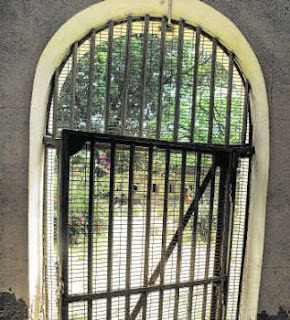CONVICT
NUMBER 3807 | PART V
Life in Kala Pani
By Francis Xavier Neelam
Maulvi Allauddin
waited at Aberdeen jetty for the boat to Ross Island
“How kind these
doctors are!” mused the Maulvi. “They are in such contrast to the other
officers, especially the native overseers. They would even take up cudgels with
the Chief Commissioner some times.”
The boat, pulled
by six convict oarsmen approached the jetty.
“Hold water. Ship your oars. Bear off,” the coxswain shouted
orders. The boat gently touched the
jetty. A convict took the head rope and tied it to the bollard, then made fast
the stern rope also.
“Assalam ale kum, Maulvi saab…”, the
coxswain greeted. “Alekum assalaam
Hemraj”, the Maulvi replied. Everyone in
Port Blair knew Hemraj for his daring escapade and recapture. They loved him
also for his courteous manners. Hemraj
gently helped the Maulvi into the boat.
“Oars…oars forward…give way…”,.. The boat glided away towards Ross. A gun boomed in the distance; another
replied. Slowly a huge, dark ship
emerged from behind Ross
Island
“Another
shipload of convicts…” the Maulvi thought. His mind went back to the time of
his own arrival in the islands. He came
in a paddle-wheel steamer, spending many days in the cage-like dungeons in the
hold of the ship. It was the 22nd
of January 1860. He remembered the date quite clearly, hardly two years after
the founding of the dreaded penal colony of ‘Kala Pani’. He remembered
getting into the waiting boat, the muster on Ross Island Chatham and Aberdeen
During the first
muster itself the Maulvi was made to fall out and present himself before the Superintendent. “So, you are the famous Maulvi, Syed Alluddin
Hyder, of Hyderabad
“Oars…”,
Hemraj’s shout brought the Maulvi to the
present. He thanked him and stepped off
the boat on to the jetty. Supporting himself with a stick he started the climb
towards the hospital. “How different is
Ross now from those days”, he thought. Convicts in white dress and turbans
greeted him. Officers in starched white uniforms walked about. Children played,
shouting, on the lawns of neatly laid out gardens. A game of tennis was in progress. The spire of the stone-built church could be
seen rising against the sky. English memsahibs in colourful, printed frocks
and bonnets walked, holding parasols as their ayahs walked behind them with their children. They too greeted the Maulvi affectionately
and enquired about his health.
Maulvi Allauddin
paused for a while on the steps. From there he could see the cemetery. The tombstones were clearly visible. Some
were ornate, with marble plaques. All
those who slept there were known to him.
He was present at most of the funerals. The most touching was that of
baby Lawrence, the child of Lawrence and Jemima Carthy. He lived only 22
hours…’Sweet Babe, he glanced into our world to see a sample of our misery,
then turned away his languid eye, to drop a tear or two -- & die…”. The memory brought tears to the eyes of the
Maulvi.
A few more steps
brought him to the hospital. The huge
brick walled structure was impeccably maintained. Uniformed nurses and ward boys moved about in
spotless white uniforms. The patients
sat on long benches; some were in chains – the ‘dangerous’ ones. There were
Andamanese too, properly dressed!
In the early
days there were no doctors -- only a couple of ‘apothecaries’. The mortality
rate was very high then, from disease, accidents, attacks by aborigines,
murders, executions… He gazed at the
grave of Apothecary A.S. Xavier. His wife Alison and daughter Gertrude also
slept by his side, in a double grave.
The doctors were
themselves vulnerable. There were three
buried on the other side, in Port Blair cemetery. His thoughts went to Surg.
Maj. Joseph Dougall, the late Senior Medical Officer. It was he who devised the
truss for his hernias. Maulvi recollected with nostalgia how kind the doctor
was to him, and to all convicts. This
led to an occasional row with the Superintendents who felt that the convicts
were being pampered by the medical officers.
Dr. Dougall found a special cure for leprosy from the oil of the gurjan tree that grew in plenty in the
forests of the Andaman Islands . His favourite among the convicts was Rasool
Baksh, a ‘harmless lunatic’. When Gen.
Stewart ordered him to be flogged for speaking disrespectfully Dougall fought
with him to stall the punishment. Unfortunately he fell victim to typhoid and
died at the young age of 44. Life in
Kala Pani would have been much more difficult if not for the kind-hearted
doctors.
Maulvi Allauddin
reached the outpatient department and sat on the bench, waiting for Surg. Maj.
Keefer.
(Next: Part VI – Conditional release)



